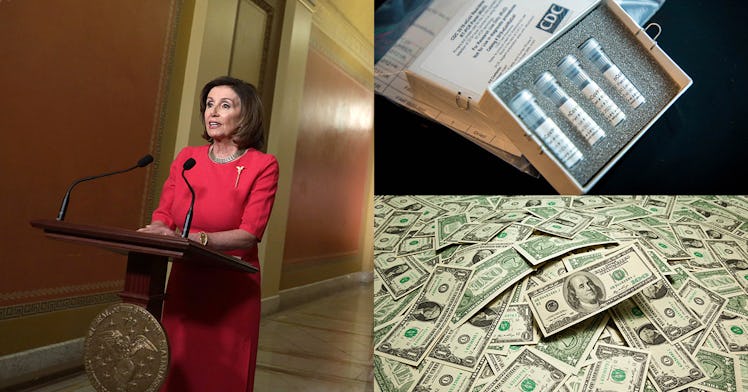Here’s What the Families First Coronavirus Response Act Actually Does
What you need to know about the first major benefit expansion in response to COVID-19.

So far, two bills specifically addressing the coronavirus crisis have become law. The first was an allocation of $8.3 billion in emergency funds to the federal agencies responding directly to the outbreak, the Centers for Disease Control, Small Business Administration, and the Department of State among them.
The other was the Families First Coronavirus Response Act. According to the Congressional Research Service summary, it “responds to the coronavirus outbreak by providing paid sick leave and free coronavirus testing, expanding food assistance and unemployment benefits, and requiring employers to provide additional protections for health care workers.” In other words, it does a lot. Here’s what you need to know about the first major benefit expansion of the COVID-19 era that hopefully won’t be the last.
Nutrition Programs
There is a lot of additional funding to shore up existing nutritional programs: $500 million for WIC, $400 million for the Emergency Food Assistance Program, $250 million for senior nutrition programs like Meals on Wheels, and $100 million for nutrition programs in American territories. SNAP, previously known as food stamps, will receive “such amounts as necessary” to cover extra allotments for families with children whose schools closed due to the public health emergency. Waivers are also included for certain normally mandatory qualifications for many of these programs such as tests to determine nutritional risk for WIC and SNAP’s work and work training requirements.
States will also be allowed to apply for federal funding to meet increased demand for school breakfast and lunch programs. Meals served through such programs can now be served outside or school and childcare settings — which makes sense, given that most are closed. And if food supply chains are disrupted, they won’t have to meet the program’s normal nutritional standards.
Additionally, the Secretary of Agriculture can purchase commodities for emergency distribution as necessary if, as seems likely, the epidemic worsens.
Coverage of Testing
The law also allocates funding to multiple agencies — Defense, Veterans Affairs, and Health and Human Services — for detection and diagnosis of COVID-19. There is also a new $1 billion fund to pay for testing and diagnosis of COVID-19 for uninsured Americans.
Public health insurance including Medicare, Medicaid, CHIP, the Indian Health Service, TRICARE, and the VA will cover testing and diagnosis costs without typical cost-sharing requirements, as will all health plans that cover federal workers. For those with private insurance, there will be no cost-sharing or need to meet a deductible or obtain prior authorization for detection and diagnosis. In other words, you won’t have to pay to find out if you’ve been infected with the coronavirus.
Personal respiratory protective devices used during outbreak will also be covered.
Family and Medical Leave
The provisions in this section apply only to public employers and private employers with fewer than 500 employees, a provision whose inadequacy has been widely noted.
Parents forced to stay home to look after kids whose schools or daycares are closed will receive two-thirds of their typical compensation, up to $200 per day with a cap of $10,000 total. They will also receive 12 weeks of leave with job protection, though employers of healthcare or emergency care providers can exclude such employees.
Sick Leave
Against, only public employees and those of companies with fewer than 500 workers are eligible for these protections. The total sick leave employees are eligible for is 80 hours for full-time employees and the average number of hours worked over two weeks for part-time employees.
Eligible workers advised by their healthcare provider to self-quarantine or those experiencing symptoms and seeking a diagnosis will receive their regular pay, up to $511 per day and $5110 total. Those caring for someone in the either of the above situations and parents of kids who can’t go to school or daycare will receive two-thirds of their regular pay, up to $200 daily with a $2,000 cap.
Tax Credits for Leave
Private employers might be paying for these expanded leave benefits up front, but they won’t be left holding the bag. The government is offering payroll tax credits for qualified sick leave wages and family leave paid by an employer.
For the self-employed, the benefits are the same: two-thirds or average daily pay or $200 a day for family and medical leave and 100 percent of average daily pay or $511 a day for emergency paid sick leave for those in quarantine or seeking a diagnosis, whichever is less.
All of these credits obviously mean a lot less money going into Social Security, so the bill specifies that the program will receive extra allocations to make up for lost funds.
Emergency Unemployment Funding
There is also a $1 billion allocation to help cover the massive spike in unemployment claims. All states can receive funding from half of this money; the other half of the funds is reserved for states where unemployment compensation claims increased by at least 10 percent compared to the same quarter fo last year. States receiving these funds are required to ease eligibility requirements, including the waiting period and work search requirements, for the duration of the public health crisis.
The feds are also increasing their match to 100 percent instead of the typical 50 percent for states with such a spike in claims. And if this money runs out, states can receive interest-free loans to cover other unemployment payments through the end of the year.